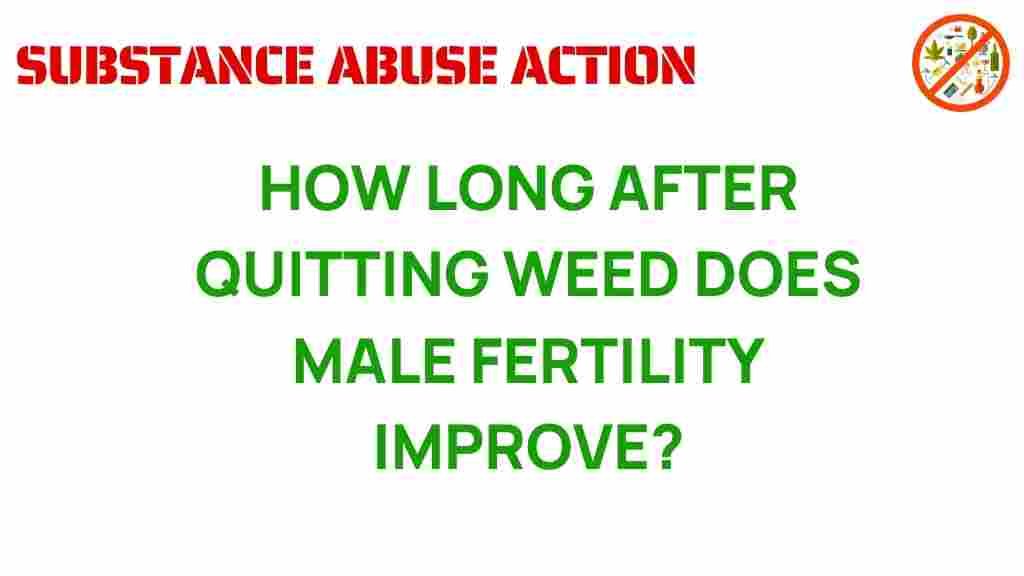The Surprising Timeline: How Quitting Weed Boosts Male Fertility
In recent years, discussions surrounding cannabis use have intensified, particularly in relation to its effects on male fertility. For many, the decision to quit weed is not just about health but also about improving their reproductive system. This article delves into how quitting cannabis can lead to significant improvements in male fertility, examining the timeline of health recovery and lifestyle changes that can enhance sperm health.
Understanding the Impact of Cannabis on Male Fertility
Before exploring the benefits of quitting weed, it’s essential to understand how cannabis affects male fertility. Research indicates that marijuana use can negatively impact sperm health and overall reproductive function. Some key effects include:
- Reduced sperm count: Regular marijuana use has been linked to lower sperm concentrations.
- Impaired sperm motility: Cannabis can affect the ability of sperm to move effectively towards the egg.
- Hormonal imbalances: THC, the active compound in cannabis, can disrupt testosterone levels, which are crucial for sperm production.
- Genetic changes: Some studies suggest that cannabis can affect the DNA quality of sperm.
Given these implications, it’s clear that quitting weed can be a powerful step towards improving male fertility.
The Timeline of Health Recovery After Quitting Weed
Understanding the timeline of recovery after quitting cannabis can help men set realistic expectations for fertility improvement. Here’s a step-by-step breakdown:
1. Immediate Changes (Days 1-7)
Within the first week of quitting weed, men may notice various immediate changes:
- Improved mood: Many individuals report enhanced mood stability and reduced anxiety.
- Better sleep quality: As the body adjusts to the absence of THC, sleep patterns may normalize, leading to more restful nights.
- Increased motivation: Quitting can lead to a renewed sense of motivation to engage in healthy lifestyle changes.
2. One Month After Quitting (Weeks 2-4)
After one month, the effects of quitting weed on the reproductive system become more pronounced:
- Hormonal balance: Testosterone levels may start to stabilize, promoting better sperm production.
- Initial improvements in sperm health: Early studies suggest that sperm motility can begin to improve at this stage.
- Enhanced general health: Quitting cannabis often leads to healthier lifestyle choices, such as improved diet and increased exercise.
3. Three Months After Quitting (Weeks 5-12)
By the three-month mark, significant changes in male fertility can be observed:
- Increased sperm count: Research shows that sperm count can increase significantly after three months of abstinence.
- Improved sperm morphology: The shape and structure of sperm may improve, increasing the chances of successful fertilization.
- Better overall reproductive health: The body continues to heal, leading to a more robust reproductive system.
4. Six Months to One Year After Quitting (Months 4-12)
Long-term abstinence from cannabis can yield profound benefits:
- Optimal sperm health: Many studies indicate that sperm health reaches optimal levels after six months of quitting.
- Enhanced fertility potential: Men who have quit cannabis for six months to a year often experience increased fertility rates.
- Improved relationships: Quitting can lead to better communication and emotional health, enhancing the overall relationship and readiness for parenthood.
Making Lifestyle Changes for Fertility Improvement
Quitting weed is just one step toward improving male fertility. Incorporating healthy lifestyle changes can further enhance sperm health and reproductive function. Here are some recommendations:
- Maintain a Balanced Diet: Focus on a diet rich in fruits, vegetables, whole grains, and lean proteins. Nutrients like zinc, vitamin C, and omega-3 fatty acids are particularly beneficial for sperm health.
- Exercise Regularly: Aim for at least 150 minutes of moderate aerobic activity per week. Exercise can help manage weight and improve hormone levels.
- Avoid Alcohol and Tobacco: Both substances can negatively impact sperm health and overall reproductive function.
- Manage Stress: High stress can affect hormonal balance and reproductive health. Techniques such as meditation, yoga, and mindfulness can be beneficial.
- Stay Hydrated: Drinking enough water is crucial for overall health and supports the reproductive system.
Troubleshooting Tips for Quitting Weed
While quitting cannabis can be challenging, there are ways to make the process smoother. Here are some tips:
- Seek Support: Consider joining a support group or talking to friends and family about your decision to quit.
- Set Clear Goals: Define your reasons for quitting and set achievable goals to help stay motivated.
- Find Alternatives: Engage in activities that can replace the time spent using cannabis, such as exercising, reading, or pursuing hobbies.
- Consult a Professional: If needed, seek help from a healthcare provider or counselor specialized in addiction recovery.
Conclusion
Quitting weed can be a transformative decision for many men, particularly those concerned about male fertility. The timeline for health recovery shows promising improvements in sperm health and overall reproductive function. By making conscious lifestyle changes and seeking support, men can enhance their fertility potential and pave the way for a healthier reproductive future.
In summary, while the effects of cannabis on sperm health are concerning, the positive changes that occur after quitting can significantly improve male fertility. If you or someone you know is considering this journey, remember that every step towards a healthier lifestyle counts. For more information on male fertility and related topics, check out this resource on lifestyle changes that can improve reproductive health.
Additionally, for those seeking professional advice, consider visiting a healthcare provider who specializes in fertility issues. You can learn more about the impact of marijuana on fertility and what you can do to improve your chances of conception.
This article is in the category Recovery and created by SubstanceAbuseAction Team
